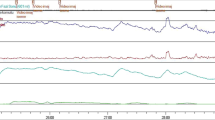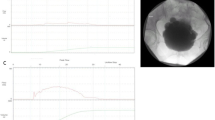Abstract
The understanding of the presentation, diagnosis, and treatment of primary bladder neck obstruction (PBNO) has evolved over the last 20 years. It was first identified 70 years ago, but the etiology is still unclear. There are multiple theories as to the etiology, including muscular and neurological dysfunction and fibrosis. Over the years, many voiding parameters and cut points and nomograms have been presented for diagnosis of nonneurogenic functional bladder outlet obstruction in young men. Until recently, there was a paucity of data on PBNO in women and children. Videourodynamics provide an accurate diagnosis of PBNO but for some patients are an invasive option. Treatments vary from watchful waiting to α-blockade to surgery, depending on the severity of symptoms, urodynamic findings, and response to medical therapy. This paper reviews the theories on etiology, incidence, presentation, and diagnostic evaluation, and briefly discusses treatment options for PBNO.
Similar content being viewed by others
References and Recommended Reading
Marion G: Surgery of the neck of the bladder. B J Urol 1933, 5:351–357.
Turner-Warwick R, Whiteside CG, Worth PHL, et al.: A urodynamic view of the clinical problems associated with bladder neck dysfunction and its treatment by endoscopic incision and transtrigonal posterior prostatectomy. B J Urol 1973, 45:44–59.
Norlen LJ, Blaivas JG: Unsuspected proximal urethral obstruction in young and middle-aged men. J Urol 1986, 135:972–976.
Diokno AC, Hollander JB, Bennett CJ: Bladder neck obstruction in women: a real entity. J Urol 1984, 132:294–298.
Axelrod SL, Blaivas JG: Bladder neck obstruction in women. J Urol 1987, 137:497–499.
Smey P, King LR, Firlit CF: Dysfunctional voiding in children secondary to internal sphincter dyssynergia: treatment with phenoxybenzamine. Urol Clin North Am 1980, 7:337–347.
Donohue JM, Combs AJ, Glassberg KI: Primary bladder neck dysfunction in children and adolescents II: results of treatment with alpha-adrenergic antagonists. J Urol 2005, 173:212–216.
Leadbetter GW, Leadbetter WF: Diagnosis and treatment of congenital bladder-neck obstruction in children. N Engl J Med 1959, 260:633–637.
Awad SA, Downie JW, Lywood D, et al.: Sympathetic activity in the proximal urethra in patients with urinary obstruction. J Urol 1976, 115:545–547.
Crowe R, Noble J, Robson T, et al.: An increase in neuropeptide Y but not nitric oxide synthase-immunoreactive nerves in the bladder from male patients with bladder neck dyssynergia. J Urol 1995, 154:1231–1236.
Tanagho EA, Miller ER, Meyers FH, et al.: Observations on the dynamics of the bladder neck. B J Urol 1966, 38:72–84.
Tanagho EA, Miller ER: Initiating of voiding. B J Urol 1970, 42:175–183.
Yalla SV, Resnick N: Initiation of voiding in humans: the nature and temporal relationship of urethral sphincter responses. J Urol 1997, 157:590–595.
Yalla SV, Gabilondo FB, Blunt KF, et al.: Functional external striated sphincter component at the bladder neck: clinical implications. J Urol 1977, 118:408–411.
Kaplan SA, Ikeguchi EF, Santarosa RP, et al.: Etiology of voiding dysfunction in men less than 50 years of age. Urology 1996, 47:836–839.
Nitti VW, Lefkowitz G, Ficazzola M, et al.: Lower urinary tract symptoms in young men: videourodynamic findings and correlation with non-invasive measures. J Urol 2002, 168:135–138.
Yang SSD, Wang CC, Hseih CH, et al.: alpha1-adrenergic blockers in young men with primary bladder neck obstruction. J Urol 2002, 168:571–574.
Nitti VW, Tu LM, Gitlin J: Diagnosing bladder outlet obstruction in women. J Urol 1999, 161:1535–1540.
Kuo HC: Videourodynamic Characteristics and lower urinary tract symptoms of female bladder outlet obstruction. Urology 2005, 66:1005–1009.
Akikwala TV, Fleischman N, Nitti VW: Comparison of diagnostic criteria for female bladder outlet obstruction. J Urol 2006, 176:2093–2097.
Kaplan SA, Te AE, Jacobs BZ: Urodynamic evidence of vesical neck obstruction in men with misdiagnosed chronic nonbacterial prostatitis and the therapeutic role of endoscopic incision of the bladder neck. J Urol 1994, 152:2063–2065.
Woodside JR: Urodynamic evaluation of dysfunctional bladder neck obstruction in men. J Urol 1980, 124:673–677.
Webster GD, Lockhart JL, Older RA: The evaluation of bladder neck dysfunction. J Urol 1980, 123:196–198.
Trockman BA, Gerspach J, Dmochowski R, et al.: Primary bladder neck obstruction: urodynamic findings and treatment results in 36 men. J Urol 1996, 156:1416–1420.
Kumar A, Banerjee GK, Goel MC, et al.: Functional bladder neck obstruction: a rare cause of renal failure. J Urol 1995, 154:186–189.
Huckabay C, Nitti VW: Diagnosis and treatment of primary bladder neck obstruction in men. Curr Urol Rep 2005, 6:271–275.
Hruz P, Danuser H, Studer UE, et al.: Non-inflammatory chronic pelvic pain syndrome can be caused by bladder neck hypertrophy. Eur Urol 2003, 44:106–110.
Delaere KPJ, Debruyne, Moonen WA: Bladder Neck Incision in the Female: A Hazardous Procedure? B J Urol 1983, 55:283–286.
Gronbaek K, Struckmann JR, Frimodt-Moller C: The treatment of female bladder neck dysfunction. Scand J Urol Nephrol 1992, 26:113–118.
Kumar A, Mandhani A, Gogoi S, Srivastava A: Management of functional bladder neck obstruction in women: use of alpha-blockers and pediatric resectoscope for bladder neck incision. J Urol 1999, 162:2061–2065.
Nitti VW: Primary bladder neck obstruction in men and women. Rev Urol 2005, 7(Suppl 8):S12–S17.
Grafstein NH, Combs AJ, Glassberg KI: Primary bladder neck dysfunction: an overlooked entity in children. Curr Urol Rep 2005, 6:133–139.
Yalla SV, Blute RD, Snyder H, et al.: Isolated bladder neck obstruction of undetermined etiology (primary) in adult male: recognition and management. Urology 1981, 17:99–108.
Kaplan SA, Santarosa RP, D’Alisera PM, et al.: Pseudodyssynergia (contraction of the external sphincter during voiding) misdiagnosed as chronic nonbacterial prostatitis and the role of biofeedback as a therapeutic option. J Urol 1997, 157:2234–2237.
Jorgensen TM, Djurhuus JC, Schroder HD: Idiopathic detrusor sphincter dyssynergia in neurologically normal patients with voiding abnormalities. Eur Urol 1982, 8:107–110.
Chassange S, Bernier PA, Haab F, et al.: Proposed cutoff values to define bladder outlet obstruction in women. Urology 1998, 51:408–411.
Lemack GE, Zimmern PE: Pressure flow analysis may aid in identifying women with uroflow obstruction. J Urol 2000, 163:1823–1828.
Defreitas GA, Zimmern PE, Lemack GE, Shariat SF: Refining diagnosis of anatomic female bladder outlet obstruction: comparison of pressure flow study parameters in clinically obstructed women with those of normal controls. Urology 2004, 64:675–679.
Blaivas JG, Groutz A: Bladder outlet obstruction normogram for women with lower urinary tract symptomatology. Neurourol Urodyn 2000, 19:553–564.
Lim CS, Abrams P: The Abrams-Griffiths nomogram. World J Urol 1995, 13:34–39.
Gravina GL, Costa AM, Ronchi P, et al.: Bladder outlet obstruction index and maximal flow rate during urodynamic study as powerful predictors for the detection of urodynamic obstruction in women. Neurourol Urodyn 2007, 26:247–253.
Combs AJ, Grafstein N, Horowitz M, et al.: Primary bladder neck dysfunction in children and adolescents I: pelvic floor electroymyography lag time: a new noninvasive method to screen for and monitor therapeutic response. J Urology 2005, 173:207–211.
Cisternino A, Zeccolini G, Calpista A, et al.: Obstructive primary bladder neck disease: evaluation of the efficacy and safety of alpha1-blockers. Urol Int 2006, 76:150–153.
Kessler TM, Studer UE, Burkhard FC: The effect of terazosin on functional bladder outlet obstruction in women: a pilot study. J Urol 2006, 176:1487–1492.
McGuire EJ, Weiss RM: Secondary bladder neck obstruction in patients with urethral values: treatment with phenoxybenzamine. Urology 1975, 5:756–758.
Harrison NW, Whitfield HN, Williams DI: The place of alpha-blocking drugs in the treatment of children with neuropathic bladders. Urol Int 1977, 32:224–231.
Austin PF, Homsy YL, Masel JL, et al.: Alpha-adrenergic blockage in children with neuropathic and nonneuropathic voiding dysfunction. J Urol 1999, 162:1064–1067.
Peng CH, Kuo HC: Transurethral incision of bladder neck in treatment of bladder neck obstruction in women. Urology 2005, 65:275–278.
Goldman HB, Zimmern PE: The treatment of female bladder outlet obstruction. B J Urol Int 2006, 98(Suppl 1):17–23.
Author information
Authors and Affiliations
Corresponding author
Rights and permissions
About this article
Cite this article
Padmanabhan, P., Nitti, V.W. Primary bladder neck obstruction in men, women, and children. Curr Urol Rep 8, 379–384 (2007). https://doi.org/10.1007/s11934-007-0035-3
Published:
Issue Date:
DOI: https://doi.org/10.1007/s11934-007-0035-3




